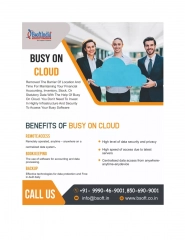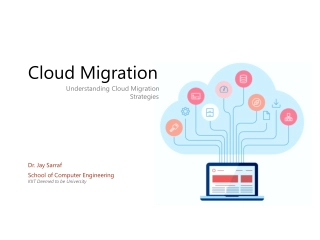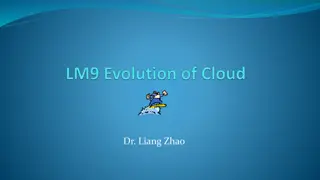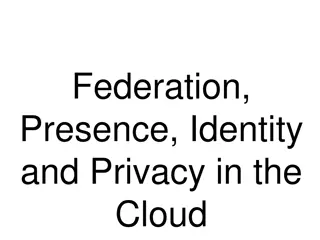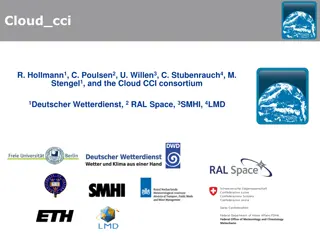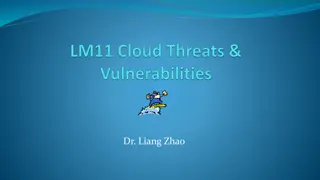Ensuring Cloud Security: Strategies for a Safe Transition
The journey to cloud computing is inevitable for most organizations, but ensuring its security is paramount. With the right approach and measures in place, cloud computing can be secure. Companies must prioritize security strategies to avoid severe consequences of a breach. Effective risk management at different layers of cloud services is crucial in navigating the evolving landscape of cyber threats in the business world.
Download Presentation

Please find below an Image/Link to download the presentation.
The content on the website is provided AS IS for your information and personal use only. It may not be sold, licensed, or shared on other websites without obtaining consent from the author. Download presentation by click this link. If you encounter any issues during the download, it is possible that the publisher has removed the file from their server.
E N D
Presentation Transcript
Road Map Mobile Security Security Auditing & Risk Analysis WLAN Security Introduction Mobile Network Overview (optional) Evolution of Wireless Network WLAN Overview Evolution of Cloud Cellular Network Security (optional) Infor. Security Essentials WLAN Threats & Vulnerabilities Confidentiality and Integrity of Cloud Mobile Security Threats WLAN Security Cloud Threats & Vulnerabilities WLAN Security Tools Mobile Devices Security (optional) Cloud Security 2
Outline Is Cloud Computing Secure? Security Characteristics Security Risks Cloud Security Simplified 3
Is Cloud Computing Secure? For most organizations, the journey to cloud is no longer a question of if but rather when , and a large number of enterprises have already travelled some way down this path. Is cloud computing secure? A simple answer is: Yes, if you approach cloud in the right way, with the correct checks and balances to ensure all necessary security and risk management measures are covered. 4
Is Cloud Computing Secure? Companies ready to adopt cloud services are right to place security at the top of their agendas. the consequences of getting your cloud security strategy wrong could not be more serious. As many unwary businesses have found to their cost in recent high-profile cases, a single cloud-related security breach can result in an organization severely damaging its reputation or, worse, the entire business being put at risk. 5
Is Cloud Computing Secure? Those further along their cloud path are finding that, like all forms of information security, the question boils down to effective risk management. we outlined the different layers in the cloud services stack: Infrastructure-as-a-Service (IaaS) Platform-as-a-Service (PaaS) Software-as-a-Service (SaaS) Business Process-as-a-Service (BPaaS). These layers and their associated standards, requirements and solutions are all at different levels of maturity. 6
Is Cloud Computing Secure? The world of business is becoming more uncertain, as with new system architectures come new cyber threats. No longer can the mechanisms deployed in the past be relied on for protection --Nick Gaines, Group IS Director, Volkswagen UK Different types of cloud have different security characteristics. The table in next page shows a simple comparison. (The number of stars indicates how suitable each type of cloud is for each area.) We choose to characterize these types as private, public and community clouds or hybrid to refer to a combination of approaches. 7
Security Risks Organizations with defined controls for externally sourced services or access to IT risk- assessment capabilities should still apply these to aspects of cloud services where appropriate. But while many of the security risks of cloud overlap with those of outsourcing and offshoring, there are also differences that organizations need to understand and manage. When adopting cloud services, there are four key considerations: 1. Where is my data? 2. How does it integrate? 3. What is my exit strategy? 4. What are the new security issues? --Tony Mather, CIO, Clear Channel International 9
Security Risks Processing sensitive or business-critical data outside the enterprise introduces a level of risk because any outsourced service bypasses an organization's in-house security controls. With cloud, however, it is possible to establish compatible controls if the provider offers a dedicated service. An organisation should ascertain a provider s position by asking for information about the control and supervision of privileged administrators. Organizations using cloud services remain responsible for the security and integrity of their own data, even when it is held by a service provider. Traditional service providers are subject to external audits and security certifications. Cloud providers may not be prepared to undergo the same level of scrutiny. When an organisation uses a cloud service, it may not know exactly where its data resides or have any ability to influence changes to the location of data. 10
Security Risks Most providers store data in a shared environment. Although this may be segregated from other customers data while it s in that environment, it may be combined in backup and archive copies. This could especially be the case in multi-tenanted environments. Companies should not assume service providers will be able to support electronic discovery, or internal investigations of inappropriate or illegal activity. Cloud services are especially difficult to investigate because logs and data for multiple customers may be either co- located or spread across an ill-defined and changing set of hosts. Organisations need to evaluate the long-term viability of any cloud provider. They should consider the consequences to service should the provider fail or be acquired, since there will be far fewer readily identifiable assets that can easily be transferred in-house or to another provider. 11
Cloud Security Simplified As with all coherent security strategies, cloud security can seem dauntingly complex, involving many different aspects that touch all parts of an organization. CIOs and their teams need to plot effective management strategies as well as understand the implications for operations and technology. we outline the key considerations. Management Operation Technology 12
Cloud Security Simplified Management Updated security policy Cloud security strategy Cloud security governance Cloud security processes Security roles & responsibilities Cloud security guidelines Cloud security assessment Service integration IT & procurement security requirements 10. Cloud security management 1. 2. 3. 4. 5. 6. 7. 8. 9. 13
Cloud Security Simplified Operation Awareness & training Incident management Configuration management Contingency planning Maintenance Media protection Environmental protection System integrity Information integrity 10. Personnel security 1. 2. 3. 4. 5. 6. 7. 8. 9. 14
Cloud Security Simplified Technology Access control System protection Identification Authentication Cloud security audits Identity & key management Physical security protection Backup, recovery & archive Core infrastructure protection 10. Network protection 1. 2. 3. 4. 5. 6. 7. 8. 9. 15
Acknowledgement This course is developed in non-textbook mode. We acknowledge the idea, content, and structure from: The white book of cloud Adoption The white book of cloud Security Mobile security for the rest of us Mobile Security for Dummies https://www.sfh-tr.nhs.uk/media/4866/information-security-mobile-security-for- dummies-ebook.pdf 16


